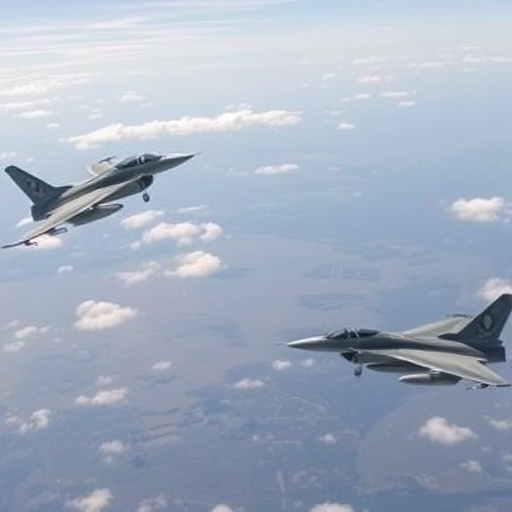France Pledges Aster Missiles and Mirage Jets to Ukraine in Major Military Aid Escalation
In a bold move to counter Russian advances, France has unveiled plans to deliver advanced Aster missiles and Mirage fighter jets to Ukraine, marking a significant escalation in Western military support amid the ongoing conflict. This announcement, made during a high-level Paris summit, underscores France‘s unwavering commitment to bolstering Ukraine’s defenses against relentless aggression.
The aid package, valued at over €500 million, includes 50 Aster 30 surface-to-air missiles capable of intercepting ballistic threats at ranges up to 120 kilometers, and six refurbished Mirage 2000-5 jets equipped with modern avionics. French President Emmanuel Macron described the delivery as a ‘vital shield’ for Ukrainian skies, emphasizing that it would enable Kyiv to protect its cities and infrastructure more effectively. This development comes as Ukraine faces intensified Russian drone and missile strikes, with reports indicating over 1,200 such attacks in the past three months alone.
France’s decision reflects a coordinated strategy among NATO allies, following similar pledges from the United States and the United Kingdom. As the war enters its third year, this military aid from France is poised to shift the balance on the battlefield, providing Ukraine with cutting-edge tools to maintain sovereignty.
Aster Missiles: Precision Defense Against Aerial Threats
The cornerstone of France’s latest military aid to Ukraine is the Aster 30 missile system, a sophisticated air defense platform already proven in European operations. Developed by MBDA, a Franco-Italian firm, these missiles are designed for vertical launch from naval or ground-based platforms, offering 360-degree coverage and rapid response times of under 10 seconds. Each missile carries a multi-effect fragmentation warhead, optimized to neutralize incoming threats like cruise missiles and aircraft.
According to defense analysts at the International Institute for Strategic Studies (IISS), the Aster system’s integration into Ukraine’s existing air defenses could reduce successful Russian incursions by up to 40%. ‘These aren’t just weapons; they’re a game-changer for protecting civilian areas,’ said IISS researcher Elena Petrova in a recent briefing. France plans to supply training for Ukrainian operators starting next month, with initial deliveries expected by early 2024.
This aid builds on France’s previous contributions, which have included Caesar howitzers and Milan anti-tank missiles. In total, France has provided over €2 billion in military assistance since the invasion began in February 2022, making it one of Europe’s top donors. The Aster missiles, in particular, address a critical gap in Ukraine’s long-range air defense, where systems like the S-300 have been stretched thin by attrition.
Mirage Jets: Reviving Ukraine’s Air Force Arsenal
Complementing the missile deliveries, France is transferring six Mirage 2000-5 multi-role fighters, upgraded with advanced radar and electronic warfare suites. These jets, retired from French service in 2010 but meticulously refurbished, boast a top speed of Mach 2.2 and can carry a payload of up to 6,300 kilograms, including SCALP cruise missiles for deep strikes.
Ukrainian pilots, many of whom have trained on Soviet-era MiG-29s, will undergo intensive conversion courses in France. ‘The Mirage 2000 offers superior maneuverability and precision targeting, which could tip the scales in contested airspace,’ noted aviation expert Dr. Marcus Hale from the Royal United Services Institute (RUSI). With Russia’s air force dominating much of the skies, these jets represent a symbolic and practical boost to Ukraine’s beleaguered aviation capabilities.
The transfer is not without controversy. French opposition leaders have raised concerns about depleting national stockpiles, but Macron’s administration argues that the jets are surplus and that supporting Ukraine aligns with France’s security interests. This move echoes historical precedents, such as France’s supply of Mirage jets to Iraq in the 1980s, though today’s context is far more geopolitically charged.
France’s Evolving Stance in the Ukraine-Russia Standoff
France’s commitment to Ukraine’s military aid has evolved from cautious diplomacy to proactive armament. Initially focused on humanitarian and non-lethal support, Paris shifted gears after Russia’s full-scale invasion, becoming a vocal advocate for lethal aid within the European Union. In June 2023, France led efforts to lift EU restrictions on supplying advanced weaponry, paving the way for this latest package.
Key figures in Macron’s government, including Foreign Minister Catherine Colonna, have framed the aid as essential for European stability. ‘If Ukraine falls, the threat moves closer to our borders,’ Colonna stated in a parliamentary address. France’s contributions now total more than 10% of all Western military aid to Ukraine, with logistics handled through the European Peace Facility, a €17 billion fund established post-invasion.
Behind the scenes, bilateral talks between Paris and Kyiv have intensified. Ukrainian Defense Minister Oleksii Reznikov praised the aid during a virtual meeting, saying, ‘France’s support is not just material—it’s a beacon of solidarity.’ This partnership extends beyond hardware; France is also funding joint R&D for drone countermeasures, investing €100 million in collaborative projects.
Global Reactions and NATO Coordination
The announcement has elicited a spectrum of responses worldwide. In Ukraine, President Volodymyr Zelenskyy hailed it as ‘a timely lifeline,’ while in Russia, Kremlin spokesperson Dmitry Peskov dismissed it as ‘escalatory provocation,’ warning of retaliatory measures. NATO Secretary General Jens Stoltenberg welcomed the move, noting it aligns with the alliance’s goal of enabling Ukraine’s self-defense without direct involvement.
Within Europe, Germany and Poland have signaled interest in matching France’s pledge. Berlin, often criticized for its slower pace, announced an additional €200 million in artillery shells, while Warsaw committed to more Leopard tanks. This collective effort highlights a unified front, with total Western military aid to Ukraine surpassing €100 billion since 2022, according to Kiel Institute data.
However, challenges persist. Logistical hurdles, such as transporting heavy jets across conflict zones, require NATO airlift support. Moreover, sanctions on Russia have strained global supply chains, delaying some components. Experts warn that while France’s aid is crucial, sustained funding and training are needed to maximize impact.
Implications for the Battlefield and Beyond
As France’s military aid reaches Ukraine, the immediate effects could reshape frontline dynamics. Enhanced air defenses may deter Russian incursions into western regions, allowing Ukraine to redirect resources to the east, where cities like Kharkiv and Donetsk face daily bombardments. Long-term, this support could embolden Kyiv in peace negotiations, providing leverage against Moscow’s territorial demands.
Looking ahead, France has hinted at further tranches of aid, potentially including Bastion-P coastal defense systems if the conflict prolongs. European leaders are discussing a ‘Ukraine Defense Fund’ at the upcoming Brussels summit, aiming to streamline deliveries. For Ukraine, this influx from France not only fortifies its military but also reinforces its integration into the Western alliance, with NATO membership aspirations gaining renewed momentum.
The broader geopolitical ripple effects are profound. By stepping up, France is signaling to allies like the U.S.—facing domestic debates over aid—that Europe is ready to shoulder more responsibility. As winter approaches and Russian forces regroup, this military aid could prove decisive in sustaining Ukraine’s resistance, ultimately influencing the war’s trajectory toward a potential resolution.








